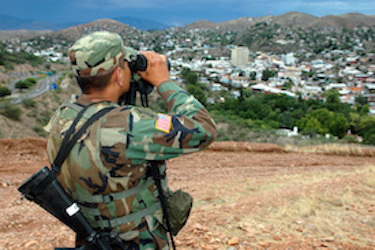Perspective: The Myth of the Mexican ‘Cartels’

Perspective: The Myth of the Mexican ‘Cartels’
Guadalupe Correa-Cabrera
Key US politicians and interest groups have blamed the so-called drug “cartels” for the fentanyl crisis that has resulted in an unprecedented number of drug overdose deaths throughout the country. CDC’s National Center for Health Statistics reported more than 100,000 drug overdose deaths in the United States during 2021; the numbers keep growing. Some label fentanyl as a weapon of mass destruction and propose to formally designate Mexican cartels as foreign terrorist organizations. With this idea in mind, Senator Lindsey Graham wants the US to unleash its “fury and might” on these enterprises. Some others have even suggested to “declare a war” on them—like Reps. Dan Crenshaw and Mike Waltz who recently introduced legislation for creating the so-called Authorization for Use of Military Force (AUMF).

US National Guard Soldier Observing Mexico Across the Border, Public Domain
This all would justify the utilization of US military actions directly in Mexico’s territory, allegedly to dismantle the cartels. There are many problems with this logic, but a key one has to do with the erroneous definition of these criminal organizations. In fact, we are not strictly talking about cartels, because their members do not negotiate peacefully, nor do they establish agreements to control supply—and hence prices—in order to maximize profits. On the contrary, they violently fight among themselves for the control of territories and drug markets (known as plazas).
What is more, they do not seem to be the super-powerful criminal groups led by the ruthless narcos featured in the dramatized Netflix series that characterize Mexico as a failed state or a narco-state. Due to the nature of their operations and their transnational character and reach, it is difficult to believe in the existence of omnipotent hierarchical organizations led by unsophisticated Mexican drug lords, such as El Chapo and his sons, El Mayo Zambada, El Mencho, and others. What many mistakenly denominate as a cartel is essentially a transnational network of smaller and relatively independent businesses operating horizontally and easily explained by social network analysis or social systems theory.
In other words, and by using military analysis, we are talking about complex adaptive systems formed by drug manufacturers, distributors, brokers, wholesalers and retailers, sellers of precursors, and other facilitators of the drug trade of different nationalities—including US citizens, of course—such as corrupt customs officers, politicians and law enforcement agents, financial intermediaries, paramilitary enforcers, killers, and lookouts, among others. Such a configuration of illicit drug markets in the Western Hemisphere has been the result of the militarization of the US anti-narcotics strategy and cooperation negotiated or imposed mainly by US law enforcement agencies upon countries of the Global South, such as Mexico and Colombia.
Hence, it is not surprising either that one cannot clearly identify the presence of cartels of US origin in US territory, where the distribution and consumption of all types of drugs—not only fentanyl—is colossal, notwithstanding prohibition. What is also evident is the ineffectiveness of the US government to fight the drug addiction problem overall and the fentanyl crisis in particular, as well as the negligence of its agencies to dismantle networks of corruption prevalent in the US that facilitate this profitable business. Otherwise, one cannot explain the massive distribution of (and access to) drugs throughout the US The reluctance to acknowledge these facts and the overall responsibility of the US government in the configuration of the so-called fentanyl crisis, as well as the failure of US law enforcement agencies and US drug policies to stop this growing crisis in the past few decades is unsettling.
It is hard to believe that the US government insists on implementing the same policies that have failed consistently for a half century and have cost US citizens over a trillion dollars since 1971, according to some estimates. The Drug Enforcement Agency’s “kingpin strategy,” an essential focus on the drug supply, a militarized drug enforcement approach centered on the US-Mexico border, and the potential use of US military force on Mexican soil are a recipe for a colossal failure. Ignoring the demand side of illicit drug markets and leaving behind public health policies to fight drug addiction, as well as strategies based on dismantling drug supply networks operating on US soil, have proven to be quite ineffective. The diagnosis of the drug problem and the fentanyl crisis seems to be based on half-truths or even on false premises, starting with a mistaken conceptualization of the term “drug cartel.”
The myth of the Mexican cartels and omnipotent drug lords, reproduced by the media and public opinion in general, has been utilized to justify futile strategies and immense budgets assigned to agencies that have failed to accomplish their basic missions. The support of current drug policies and proposals to destroy cartels on Mexican soil might be very convenient for certain electoral campaigns and to fulfill geopolitical goals, as well as for military contractors that are part of the so-called border-military-industrial complex. Through the continuation of such policies, drug supply networks will only strengthen and extend their reach. Drug cartels, as such, do not exist, but the idea of their alleged all-powerfulness vindicates a militarized anti-narcotics strategy that fuels a continuous low-intensity conflict south of the border. This myth justifies a war that can never be won imposed upon the peoples of our continent.






